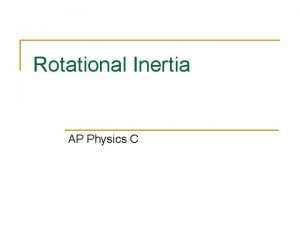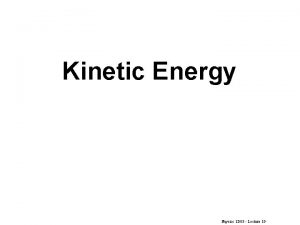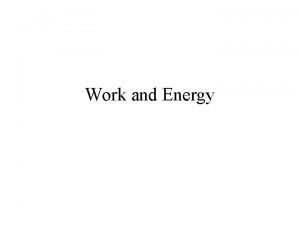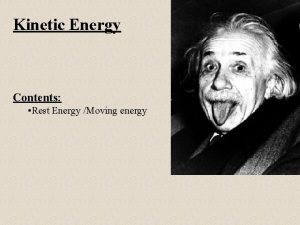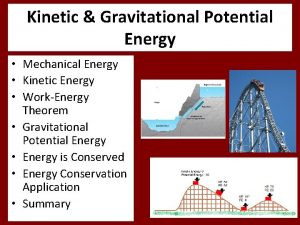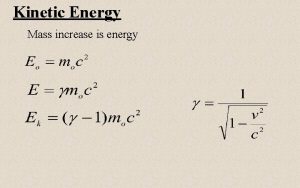Kinetic Energy Physics 1 D 03 Lecture 19







- Slides: 7

Kinetic Energy Physics 1 D 03 - Lecture 19

Kinetic Energy Definition: Definition for a particle moving with speed v, the kinetic energy is K = ½ mv 2 (a SCALAR quantity) Then the Work-Energy Theorem says: The total work done by all external forces acting on a particle is equal to the increase in its kinetic energy. W = ΔK = Kf – Ki Physics 1 D 03 - Lecture 19

• Kinetic Energy is measured in joules (1 J=1 N·m). • Kinetic energy is a scalar; the work-energy theorem is a scalar relation. • This theorem is equivalent to Newton’s Second Law. In principle, either method can be used for any problem in particle dynamics. Physics 1 D 03 - Lecture 19

How to deal with friction If there is friction in the system, then: ΔK=Wf = -ffd Since ΔK = Kf - Ki = -ffd Therefore Kf = Ki - ffd Physics 1 D 03 - Lecture 19

Example 1 A bartender slides a 1 -kg glass 3 m along the bar to a customer. The glass is moving at 4 m/s when the bartender lets go, and at 2 m/s when the customer catches it. Find the work done by friction, and calculate the force of friction. Physics 1 D 03 - Lecture 19

Example 2 A 6. 0 kg block initially at rest is pulled to the right for 3. 0 m with a force of 12 N over a surface. Determine its final velocity if: 1. a) the surface has no friction 2. b) the surface has a coefficient of kinetic friction of 0. 15 3. 4. How else could we solve this problem ? ? Try it !!! Physics 1 D 03 - Lecture 19

Example 3 A block of mass 1. 6 kg resting on a frictionless surface is attached to a horizontal spring with a spring constant k=1. 0 x 103 N/m. The spring is compressed to 2. 0 cm and released from rest. a) Calculate the speed of the block as it passes the x=0 point. b) Calculate the block’s speed at the x=1. 0 cm point. c) Calculate the block’s speed at the x=0 cm point if there is a constant frictional force of 4. 0 N. Physics 1 D 03 - Lecture 19
